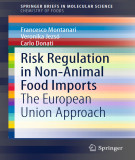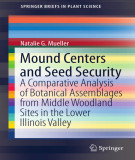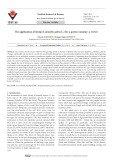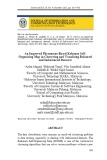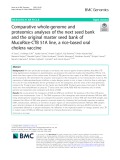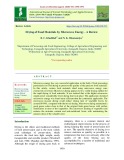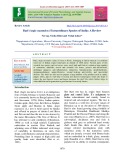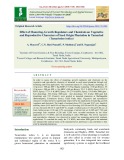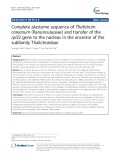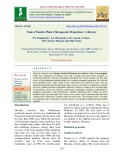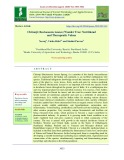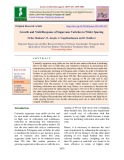
Seed origin
-
Ebook "Risk regulation in non-animal food imports: The European union approach" aims at providing a general understanding of the rationale – scientific as well as political – behind EU policy and related risk management decisions in the area on non-animal food imports. Lately, various menaces associated with imported food and feed of non-animal origin appeared in the media: imported sprout seeds contaminated with E. coli, strawberries containing hepatitis A or noro viruses, to name but a few, are now as much discussed as the different well-known meat scandals.
 109p
109p  tudohanhtau1006
tudohanhtau1006
 29-03-2024
29-03-2024
 3
3
 1
1
 Download
Download
-
Ebook "Mound centers and seed security: A comparative analysis of botanical assemblages from middle woodland sites in the lower illinois valley" integrates an interpretation of these two historical trends. Unlike most journal articles on related subjects, the volume includes a lengthy review of literature on both Hopewell studies and Middle Woodland agriculture, making it a useful resource for researchers starting out in either field.
 74p
74p  manmanthanhla0201
manmanthanhla0201
 26-02-2024
26-02-2024
 2
2
 1
1
 Download
Download
-
Ebook "Edible medicinal and non-medicinal plants - Volume 2: Fruits" covers edible fruits/seeds used fresh or processed, as vegetables, spices, stimulants, pulses, edible oils and beverages. It encompasses species from the following families: Clusiaceae, Combretaceae, Cucurbitaceae, Dilleniaceae, Ebenaceae, Euphorbiaceae, Ericaceae and Fabaceae.
 1112p
1112p  damtuyetha
damtuyetha
 16-02-2023
16-02-2023
 3
3
 1
1
 Download
Download
-
The cultivated tetraploid cotton species (AD genomes) was originated from two ancestral diploid species (A and D genomes). While the ancestral Agenome species produce spinnable fibers, the D- genome species do not. Cotton fibers are unicellular trichomes originating from seed coat epidermal cells, and currently there is an immense interest in understanding the process of fiber initiation and development.
 16p
16p  vineville
vineville
 08-02-2023
08-02-2023
 1
1
 1
1
 Download
Download
-
Genomic insights into the origin, domestication and genetic basis of agronomic traits of castor bean
Castor bean (Ricinus communis L.) is an important oil crop, which belongs to the Euphorbiaceae family. The seed oil of castor bean is currently the only commercial source of ricinoleic acid that can be used for producing about 2000 industrial products.
 27p
27p  vialfrednobel
vialfrednobel
 29-01-2022
29-01-2022
 8
8
 0
0
 Download
Download
-
Hydropriming has the potential to ameliorate the stress-induced ill effects on yields of the crop plants and quality of seed produced. In the present study, half of the fresh seeds of maize hybrid, PEHM 5 and its parental lines (Female - CM 150, Male - CM 151) were subjected to accelerated aging test for bringing down the viability and vigour, thereby creating low vigour lots while high vigour lots consisted of fresh seeds, which were hydroprimed (30 h at 25°C). Half of the hydroprimed seeds were surface dried while the other half were redried back to the original moisture contents.
 14p
14p  hanthienngao
hanthienngao
 30-11-2021
30-11-2021
 12
12
 1
1
 Download
Download
-
The concern for the issues related to the growing needs of human civilization like resource depletion, pollution, climate changes, and health risk has led to a search for eco-friendly alternatives to environmental problems. Recently, hemp started gaining popularity for its medicinal, nontoxic, greenhouse negative, and biodegradable properties. Originating from the steppes of Central Asia, Cannabis sativa L. (hemp) is one of the oldest domesticated plants known to humans.
 14p
14p  tudichquannguyet
tudichquannguyet
 29-11-2021
29-11-2021
 10
10
 1
1
 Download
Download
-
This research proposed an improved pheromonebased PKSOM algorithm known as iPKSOM to solve the mentioned problem. Six different datasets, i.e. Iris, Seed, Glass, Titanic, WDBC, and Tropical Wood datasets were chosen to investigate the effectiveness of the iPKSOM algorithm. All datasets were observed and compared with the original KSOM results.
 26p
26p  spiritedaway36
spiritedaway36
 28-11-2021
28-11-2021
 8
8
 1
1
 Download
Download
-
We have previously developed a rice-based oral vaccine against cholera diarrhea, MucoRice-CTB. Using Agrobacterium-mediated co-transformation, we produced the selection marker–free MucoRice-CTB line 51A, which has three copies of the cholera toxin B subunit (CTB) gene and two copies of an RNAi cassette inserted into the rice genome.
 12p
12p  vilichoo2711
vilichoo2711
 25-06-2021
25-06-2021
 15
15
 1
1
 Download
Download
-
Collar rot (Sclerotium rolfsii Sacc.) of chilli (Capsicum annuum L.) is one of the devastating soil-borne diseases of fungal origin, due to which 16–80% yield loss is recorded annually according to the severity of the disease. An integrated disease management approach was developed for the management of collar rot of chilli using fungicide, biocontrol agents and an organic amendment.
 8p
8p  nguaconbaynhay7
nguaconbaynhay7
 15-08-2020
15-08-2020
 20
20
 1
1
 Download
Download
-
Microwave energy has very successful application in the field of food processing particularly for food drying to preserve the quality of the precious food materials. In this article, various food materials dried using microwave energy were extensively reviewed. Microwave drying appears to be a viable drying method for the rapid drying of food materials. It was noticed that at the higher microwave output power considerably lower drying time took place. The application of pulsed microwave energy was found more efficient than the continuous application.
 24p
24p  caygaocaolon6
caygaocaolon6
 30-07-2020
30-07-2020
 12
12
 1
1
 Download
Download
-
Hot pepper (chillies) is known from prehistoric time in Peru. They are believed to have originated in the tropical America. It is also said that chillies have originated in the Latin American region of the Mexico and Guatemala as a wild crop around 7500 B.C. as per the remains of the pre-historic Peru. The people native to these places domesticated this crop in and around 3000 B.C evidenced by remains found in pottery from Puebla and Oaxaca. chilli is said to be the first ever domesticated crop from any damage from birds. Columbus carried chilli seed to Spain in 1493.
 7p
7p  angicungduoc6
angicungduoc6
 22-07-2020
22-07-2020
 10
10
 2
2
 Download
Download
-
Bael, Aegle marmelos (Linn.) Correa ex Roxb., belonging to family rutaceae is a medium sized tree of Indian origin found upto an altitude of 1200 meter. Various parts of this versatile tree species such as leaves, roots, seed, bark and fruit etc contain a large number of coumarins, alkaloids, sterols and essential oils hence, possess anti-microfilarial, antifungal, analgesic, anti-inflammatory, antipyretic, hypoglycaemic, antidyslipidemic, immunomodulatory, antiproliferative, wound healing, anti-fertility, and insecticidal abilities.
 18p
18p  kethamoi6
kethamoi6
 29-06-2020
29-06-2020
 23
23
 0
0
 Download
Download
-
In order to assess the effect of manuring, growth regulators and chemicals on the vegetative and reproductive character of tamarind in seed raised plantation through soil drenching and foliar application.
 6p
6p  angicungduoc5
angicungduoc5
 12-06-2020
12-06-2020
 29
29
 2
2
 Download
Download
-
Plastids originated from cyanobacteria and the majority of the ancestral genes were lost or functionally transferred to the nucleus after endosymbiosis. Comparative genomic investigations have shown that gene transfer from plastids to the nucleus is an ongoing evolutionary process but molecular evidence for recent functional gene transfers among seed plants have only been documented for the four genes accD, infA, rpl22, and rpl32.
 12p
12p  viminato2711
viminato2711
 22-05-2020
22-05-2020
 19
19
 1
1
 Download
Download
-
In angiosperms, the endosperm plays a crucial placenta-like role in that not only is it necessary for nurturing the embryo, but also regulating embryogenesis through complicated genetic and epigenetic interactions with other seed compartments and is the primary tissue in which genomic imprinting occurs.
 13p
13p  viminato2711
viminato2711
 22-05-2020
22-05-2020
 10
10
 0
0
 Download
Download
-
Spider plant [Gynandropsis gynandra (L.) Briq.], an economically promising African leafy vegetable, characterized for leaf yield components and nutritive quality, exhibits poor seed germination that hinders a wider expansion of the crop in urban and periurban horticultural systems.
 14p
14p  viuchiha2711
viuchiha2711
 21-04-2020
21-04-2020
 14
14
 1
1
 Download
Download
-
Morinda citrifolia Linn. belongs to family Rubiaceae, also called as „noni‟ is an evergreen shrub that originated in Southeast Asia and is being used from many centuries as traditional medicine. Various communities throughout the world consume the fruit and leaves of this traditional medicinal plant for its various therapeutic properties. M. citrifolia parts including fruits, seeds, barks, leaves, and flowers are utilized on their own for individual nutritional and therapeutical values, however, the fruit is considered to contain the most valuable chemical compounds.
 7p
7p  kethamoi4
kethamoi4
 16-04-2020
16-04-2020
 14
14
 1
1
 Download
Download
-
Chironji (Buchanania lanzan Spreng.) is a member of the family Anacardiaceae and it is originated in the Indian sub-continent, is an excellent multipurpose tree species. Traditional indigenous knowledge reveals the immense value of almost all parts of the plant i.e. roots, leaves, fruits, seeds and gum for various medicinal uses. Chironji (Buchanania lanzan) is an important non-wood tree species found in deciduous forests throughout the greater part of India. It is a multipurpose tree and very important plant for rural and tribal economy.
 10p
10p  chauchaungayxua4
chauchaungayxua4
 22-03-2020
22-03-2020
 13
13
 1
1
 Download
Download
-
Currently sugarcane crop yields are low and its area under cultivation is declining due to its high cost of cultivation and continuous reduction in announcing less remunerative prices to the farmers by the policy makers. Of late the area under this crop is continuously declining in Telangana state of India. In order to facilitate the farmers to get lucrative prices and to increase area under this crop, sugarcane yields have to be enhanced more than 250 t/ha.
 4p
4p  nguathienthan2
nguathienthan2
 25-12-2019
25-12-2019
 22
22
 0
0
 Download
Download
CHỦ ĐỀ BẠN MUỐN TÌM









